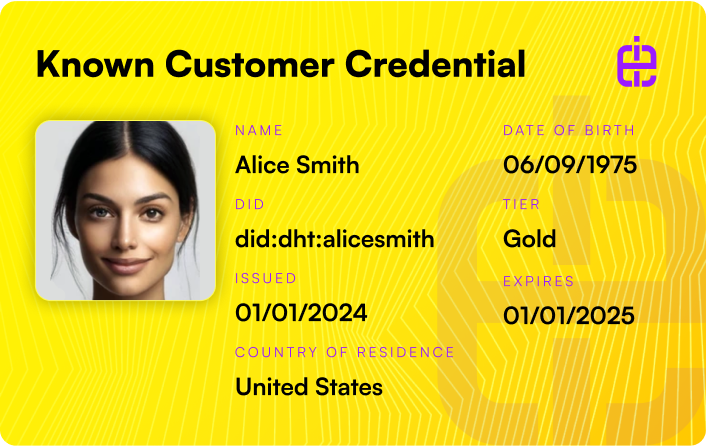Requesting a Known Customer Credential
Known Customer Credentials (KCCs) are Verifiable Credentials designed to streamline the Know Your Customer (KYC) process for tbDEX protocol users. KCCs help in gaining access to PFIs that provide regulated financial services.
For a comprehensive exploration of the practical applications and compliance considerations of KCCs, refer to the KCC Compliance Guide. It provides detailed examples and insights into how KCCs align with certain regulatory requirements. This offers valuable context for those overseeing the implementation and management of KCCs.
In this guide, we'll cover:
- Identity Verification (IDV): How your Wallet App initiates and supports the IDV process conformant with Self Issued OpenID Provider V2 (SIOPv2) and OpenID for Verifiable Presentations (OID4VP), ensuring users can securely verify their identity.
- Credential Request: The steps needed for your Wallet App to request a KCC on a user's behalf after successful IDV.
- Credential Management: How the Wallet utilizes existing credentials for KCC requests and securely stores the KCC itself.
Environment Setup
Install Dependencies
Your Wallet App will require libraries for handling HTTP requests and processing JSON Web Tokens(JWTs). You can include these libraries in your project by installing the following dependencies:
npm install @web5/credentials@1.1.1
npm install @web5/dids@1.1.5
npm install @node-fetch
Framework Flexibility
The core logic provided in the code snippets of this guide is designed to be adaptable across different development environments. The code examples primarily cater to a Node.js environment however, the concepts shown can be applied within various frameworks or platforms, including web applications, server-side applications, and mobile applications. Depending on your development context, you'll need to adjust aspects like HTTP request handling, and secure storage to align with the practices and libraries of your chosen framework or platform.
IDV Process
Identity Verification is a critical component of typical KYC requirements, where certain types of Personally Identifiable Information (PII) are collected and verified from an individual. IDV is a crucial step before a KCC can be issued.
sequenceDiagram
autonumber
participant App as Customer's Wallet App
participant DID as DID Resolver
participant I as Issuer
App->>+DID: Resolve Issuer's DID
DID-->>-App: DID Document with IDV Service Endpoint
App->>+I: HTTP Request to IDV Service Endpoint
I->>I: Process Request
I-->>-App: SIOPv2 Authorization Request
App->>App: Decode & Process SIOPv2 Auth Request
App->>+I: SIOPv2 Authorization Response with id_token (& vp_token if applicable)
I-->>-App: Process Authorization Response
1. Get IDV Endpoint
Resolve the Issuer's DID to get the IDV service Endpoint that can be found in the Issuer's DID Document:
2. Send HTTP request to Service Endpoint
Send an HTTP request to the IDV Service Endpoint:
3. Create SIOPv2 Authorization Response
Decode the Issuer's SIOPv2 Authorization Request and create a SIOPv2 Authorization Response with id_token and vp_token:
Processing the Credential Offer
After successful completion of the Identity Verification - whether via form or the necessary VCs - your Wallet application will then begin processing the credential_offer from the Issuer.
1. Extract Credential Offer
Extract and store the credential_issuer URL and pre_authorized_code from the credential offer:
2. Get Issuer's Metadata
Fetch the Issuer's Metadata from the credential_issuers URL
To construct the URL to fetch the Issuer's Metadata, the Wallet needs to append /.well-known/openid-credential-issuer to the credential_issuer URL provided in the credential_offer:
3. Get Authorization Server's Metadata
Fetch the Authorization Server's Metadata
Before the Wallet can request a KCC from the Issuer, the Wallet needs to also fetch the Issuer's Authorization Server Metadata by appending /.well-known/oauth-authorization-server to the credential_issuer URL in handleIssuerResponse():
The Server Authorization Metadata can look like this:
Server Authorization Metadata
// Issuer.js
{
"issuer": "https://issuer.example.com", // URL of the Credential Issuer
"token_endpoint": "https://issuer.example.com/token", // URL for the Access Token Request
};
4. Get Access Token
Fetch the Access Token from the Issuer's /token endpoint:
Here's an example Access Token Response from the Issuer:
Access Token Response
// Issuer.js
{
"access_token": "eyJhbGciOiJIUzI1NiIsInR5cCI6IkpXVCJ9.eyJzdWIiOiJkaWQ6ZXhhbXBsZTpPcTJ4T0J4NVVjIiwiaXNzIjoiZGlkOmV4YW1wbGU6SXNzdWVyRGlkIiwiaWF0IjoxNjE1MjM5MDIyLCJleHAiOjE2MTUzMjU0MjIsImNfbm9uY2UiOiJzYW1wbGVjbm9uY2UifQ.SflKxwRJSMeKKF2QT4fwpMeJf36POk6yJV_adQssw5c",
"token_type": "bearer",
"expires_in": 86400,
"c_nonce": "adQssw5c",
"c_nonce_expires_in": 86400
}
Request Known Customer Credential
After receiving the access_token from the Issuer, the Wallet can now send a KCC request to the credential_endpoint that was in the Issuer's Metadata.
Send Request to Issuer's Credential Endpoint
Sign and Send an HTTP POST request to the Issuer's credential endpoint:
Example Known Customer Credential
To convert the signed VC JWT into a VerifiableCredential object you can use the parseJwt() method. Here is what a decoded Known Customer Credential would look like:
{
"vcDataModel": {
"@context": ["https://www.w3.org/2018/credentials/v1"],
"type": ["VerifiableCredential"],
"id": "urn:uuid:12345678-1234-5678-1234-567812345678",
"issuer": "did:dht:z6Mkn4w6nSaWe4fjNJRvaHZwFnMm5VexvjzDeozEu2G7jC34",
"issuanceDate": "2024-01-01T19:23:24Z",
"expirationDate": "2026-05-19T08:02:04Z",
"credentialSchema": {
id: "https://vc.schemas.host/kcc.schema.json",
type: "JsonSchema"
},
"evidence": [
{
kind: "document_verification",
checks: ["passport", "utility_bill"]
},
{
kind: "sanction_screening",
checks: ["PEP"]
}
],
"credentialSubject": {
"id": "did:dht:z6MkjGSeekPGE9QfczHWyW8v2ZzJU68kqSHzV7L2dmQyuyDu",
"countryOfResidence": "US",
"tier": "Gold",
"jurisdiction": {
"country": "US"
}
}
}
}
To the user, an example KCC may look like this:

With that, you've successfully gone through the Identity Verification flow, requested a Known Customer Credential on behalf of the user, and securely stored the user's Known Customer Credential. Please note that this example is a foundational implementation. For a production environment, it's crucial to enhance this basic setup with comprehensive error handling, secure storage and security measures.
Next Steps
For an example of the complete flow for requesting and issuing a KCC, check out the Known Customer Credential Exemplar on GitHub. This exemplar provides a implementation of requesting and issuing a Known Customer Credential (KCC).